Related Research Articles

Digital Equipment Corporation (DEC)'s PDP-10, later marketed as the DECsystem-10, is a mainframe computer family manufactured beginning in 1966 and discontinued in 1983. 1970s models and beyond were marketed under the DECsystem-10 name, especially as the TOPS-10 operating system became widely used.
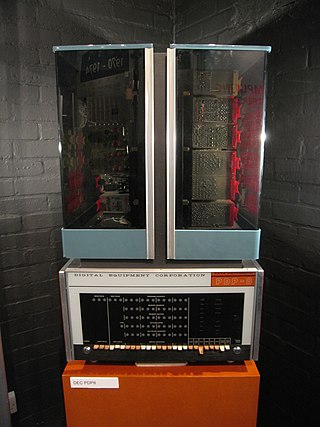
The PDP-8 is a family of 12-bit minicomputers that was produced by Digital Equipment Corporation (DEC). It was the first commercially successful minicomputer, with over 50,000 units being sold over the model's lifetime. Its basic design follows the pioneering LINC but has a smaller instruction set, which is an expanded version of the PDP-5 instruction set. Similar machines from DEC are the PDP-12 which is a modernized version of the PDP-8 and LINC concepts, and the PDP-14 industrial controller system.

The PDP–11 is a series of 16-bit minicomputers sold by Digital Equipment Corporation (DEC) from 1970 into the late 1990s, one of a set of products in the Programmed Data Processor (PDP) series. In total, around 600,000 PDP-11s of all models were sold, making it one of DEC's most successful product lines. The PDP-11 is considered by some experts to be the most popular minicomputer.

Computer operating systems (OSes) provide a set of functions needed and used by most application programs on a computer, and the links needed to control and synchronize computer hardware. On the first computers, with no operating system, every program needed the full hardware specification to run correctly and perform standard tasks, and its own drivers for peripheral devices like printers and punched paper card readers. The growing complexity of hardware and application programs eventually made operating systems a necessity for everyday use.
RT-11 is a discontinued small, low-end, single-user real-time operating system for the full line of Digital Equipment Corporation PDP-11 16-bit computers. RT-11 was first implemented in 1970. It was widely used for real-time computing systems, process control, and data acquisition across all PDP-11s. It was also used for low-cost general-use computing.
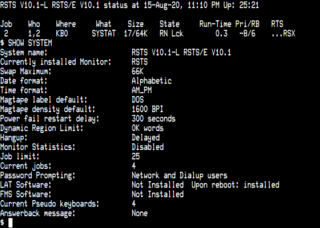
RSTS is a multi-user time-sharing operating system developed by Digital Equipment Corporation for the PDP-11 series of 16-bit minicomputers. The first version of RSTS was implemented in 1970 by DEC software engineers that developed the TSS-8 time-sharing operating system for the PDP-8. The last version of RSTS was released in September 1992. RSTS-11 and RSTS/E are usually referred to just as "RSTS" and this article will generally use the shorter form. RSTS-11 supports the BASIC programming language, an extended version called BASIC-PLUS, developed under contract by Evans Griffiths & Hart of Boston. Starting with RSTS/E version 5B, DEC added support for additional programming languages by emulating the execution environment of the RT-11 and RSX-11 operating systems.
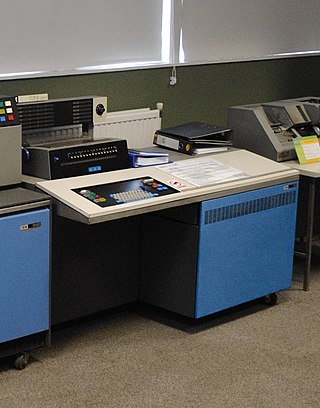
The IBM 1130 Computing System, introduced in 1965, was IBM's least expensive computer at that time. A binary 16-bit machine, it was marketed to price-sensitive, computing-intensive technical markets, like education and engineering, succeeding the decimal IBM 1620 in that market segment. Typical installations included a 1 megabyte disk drive that stored the operating system, compilers and object programs, with program source generated and maintained on punched cards. Fortran was the most common programming language used, but several others, including APL, were available.

DECtape, originally called Microtape, is a magnetic tape data storage medium used with many Digital Equipment Corporation computers, including the PDP-6, PDP-8, LINC-8, PDP-9, PDP-10, PDP-11, PDP-12, and the PDP-15. On DEC's 32-bit systems, VAX/VMS support for it was implemented but did not become an official part of the product lineup.
FOCAL is an interactive interpreted programming language based on JOSS and mostly used on Digital Equipment Corporation (DEC) Programmed Data Processor (PDP) series machines.
MBASIC is the Microsoft BASIC implementation of BASIC for the CP/M operating system. MBASIC is a descendant of the original Altair BASIC interpreters that were among Microsoft's first products. MBASIC was one of the two versions of BASIC bundled with the Osborne 1 computer. The name "MBASIC" is derived from the disk file name MBASIC.COM of the BASIC interpreter.
VSI BASIC for OpenVMS is the latest name for a dialect of the BASIC programming language created by Digital Equipment Corporation (DEC) and now owned by VMS Software Incorporated (VSI). It was originally developed as BASIC-PLUS in the 1970s for the RSTS-11 operating system on the PDP-11 minicomputer. It was later ported to OpenVMS, first on VAX, then Alpha, and most recently Integrity.
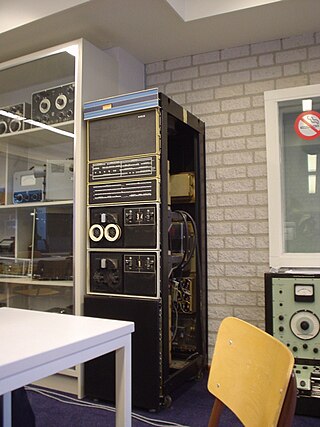
The PDP-15 was the fifth and last of the 18-bit minicomputers produced by Digital Equipment Corporation. The PDP-1 was first delivered in December 1959 and the first PDP-15 was delivered in February 1970. More than 400 of these successors to the PDP-9 were ordered within the first eight months.
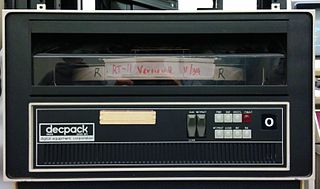
Digital Equipment Corporation's RK05 is a disk drive whose removable disk pack can hold about 2.5 megabytes of data. Introduced 1972, it is similar to IBM's 1964-introduced 2310, and uses a disk pack similar to IBM's 2315 disk pack, although the latter only held 1 megabyte. An RK04 drive, which has half the capacity of an RK05, was also offered.

NOS is a discontinued operating system with time-sharing capabilities, written by Control Data Corporation in 1975.
The CDC 1700 was a 16-bit word minicomputer, manufactured by the Control Data Corporation with deliveries beginning in May 1966.
BATCH-11/DOS-11, also known simply as DOS-11, is a discontinued operating system by Digital Equipment Corporation (DEC) of Maynard, Massachusetts. The first version of DOS-11 (V08-02) was released in 1970 and was the first operating system to run on the Digital PDP-11 minicomputer. DOS-11 was not known to be easy to use even in its day and became much less used in 1973 with the release of the RT-11 operating system.
TSS/8 is a discontinued time-sharing operating system co-written by Don Witcraft and John Everett at Digital Equipment Corporation in 1967. DEC also referred to it as Timeshared-8 and later the EduSystem 50.
The PDP-11 architecture is a 16-bit CISC instruction set architecture (ISA) developed by Digital Equipment Corporation (DEC). It is implemented by central processing units (CPUs) and microprocessors used in PDP-11 minicomputers. It was in wide use during the 1970s, but was eventually overshadowed by the more powerful VAX architecture in the 1980s.

The PDP-8/e was a model of the PDP-8 line of minicomputers, designed by the Digital Equipment Corporation to be a general purpose computer that inexpensively met the needs of the average user while also being capable of modular expansion to meet the more specific needs of advanced user.
Concise Command Language (CCL) was the term used by Digital Equipment Corporation for the Command-line interpreter / User interface supplied on several of their computing systems; its successor was named DIGITAL Command Language (DCL).
References
- ↑ for Richard Lary, who also was involved with OS/8 and RTS8. "What is a PDP 8?". Archived from the original on 2004-08-25.
- ↑ "Disk Monitor System" (PDF). BitSavers.
- ↑ COMPUTERWORLD, June 1984: "OS/278 is available for $74." "Decmate II 08/278 Digital Equipment Corp. has introduced a new version of its OS/8 ..." Computerworld. June 11, 1984. p. 130.
- ↑ File: /Licenses/os8_license.txt in os8swre.tar.Z
- ↑ An annotated list of commands is available at "OS/8 MONITOR COMMANDS".
- ↑ "My PDP8/E".
- 1 2 Moore, Rick. "OS-8 Field Service Assistance Brochure".
- ↑ "DF32/DS32 hard disk drive".
The DF32 Disk File and Control is a fixed head hard drive with a total capacity of 32K 12 bit words.
- ↑ For an explanation of the allocation algorithm, see chapter 2 of "OS/8 Software Support Manual" (PDF). Bitsavers. Digital Equipment Corporation.
- ↑ pp. 6–67 in PDP 8/e Small Computer Handbook. Digital Equipment Corporation. 1973.
- ↑ "Directory of linctape-images/os8l/ps-8-system-25.linc". Online PDP-8 Home Page.
This directory is in the format the OS/8 operating system uses. OS/8 can only store dates for an 8 year period so dates will be shown as 1970–1977 unless the media had a printed directory or other information find the correct date range.
- ↑ "The Digital Equipment Corporation PDP-8: Frequently Asked Questions".
COS-310 was a derivative of MS/8 and OS/8, but with a new text file format. The file system is almost the same as OS/8, but dates are recorded differently[...].
- ↑ For a programmer's overview of OS/8 EDIT, see "Editing Files on a PDP-8 using OS/8 EDIT". 24 May 2014.
- ↑ "4K Fortran programmer's reference manual" (PDF).